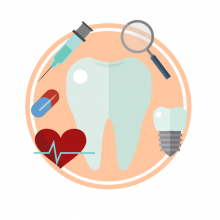Technology Overview
The technology is based on field-leading research in host-biomaterials interactions, infection, and self-assembling materials. Growing out of research at the University of Toronto Faculty of Dentistry, Materials Science and Engineering department, and Institute of Biomaterials and Biomedical Engineering, the technology utilizes antibacterial-silica (glass) self-assembled materials that respond to the presence of pathogenic bacteria by releasing the drug on demand when bacteria are present.
Benefits
- Control over drug release rate, allowing extended release timeframe to reduce frequency of antimicrobial application
- Local delivery of antibacterial precisely where needed
- Smart antibacterial release in response to pathogenic bacteria
- Compatibility with current composite restorative systems
- Precise control of drug loading during manufacturing
- The ability to reduce recurrent caries and restoration failure for 30+ years
- Prevents infection at the implant-gingiva interface without systemic exposure
- Effective in the days following surgery
- Integrates with current implant placement procedures
- Reduces likelihood of costly implant revisions
Applications
New Dental Materials for Improved Patient Outcomes
Recurrent dental caries, at the interface between a restoration and tooth, is the stated reason for over 70% of restorations performed. Despite advances in restorative bonding, caries-causing bacteria will still infiltrate this interface, degrade the bond, and form caries. Current dental restoratives have no effective ability to resist this process by combating these bacteria.
Infection of the soft tissue around dental implants in the days after surgery affects 2% of procedures, or about 200,000 patients per year in the US, leading to inflammation, pain, and potentially costly revisions. Antibiotic prophylaxis is an effective method to reduce infection risk and is used by virtually all clinicians who place dental implants. However, allergic reaction and the growing development of antibiotic resistant bacteria have both lead to calls of reduced antibiotic use. Although the societal benefits of antibiotic use reduction are important, individual implant patients may suffer.
Wound Healing
Infection is a major contributing factor to the inhibition of wound healing, increasing and prolonging inflammation, and inducing hypermetabolism, leading to chronic non-healing wounds, systemic infections, and in worst cases multi-organ failure or death. Wound infection affects 14 million patients per year, at US $10 billion in additional treatment. With the advent of antibiotic-resistant “superbugs” (such as MRSA), alternatives to systemic antibiotics have been sought. Local antibacterial wound dressings prevent chronic wound infection by antibiotic-resistant- and other bacteria while avoiding systemic antibiotic use and its associated resistance development.
However, conventional antibacterial wound dressings have limited (or no) control over antibacterial release rate, and often lack standardized testing. Maintaining an effective dose of antibacterial at the wound is critical: low doses from these dressings may breed bacterial resistance, and larger doses may be toxic. Antibacterial silver ion release from some wound dressings variable, with little evidence that test release rates apply to the clinical wound environment. In non-silver dressings, antibacterial drug is infused in the dressing with limited control over drug dose.
Company





